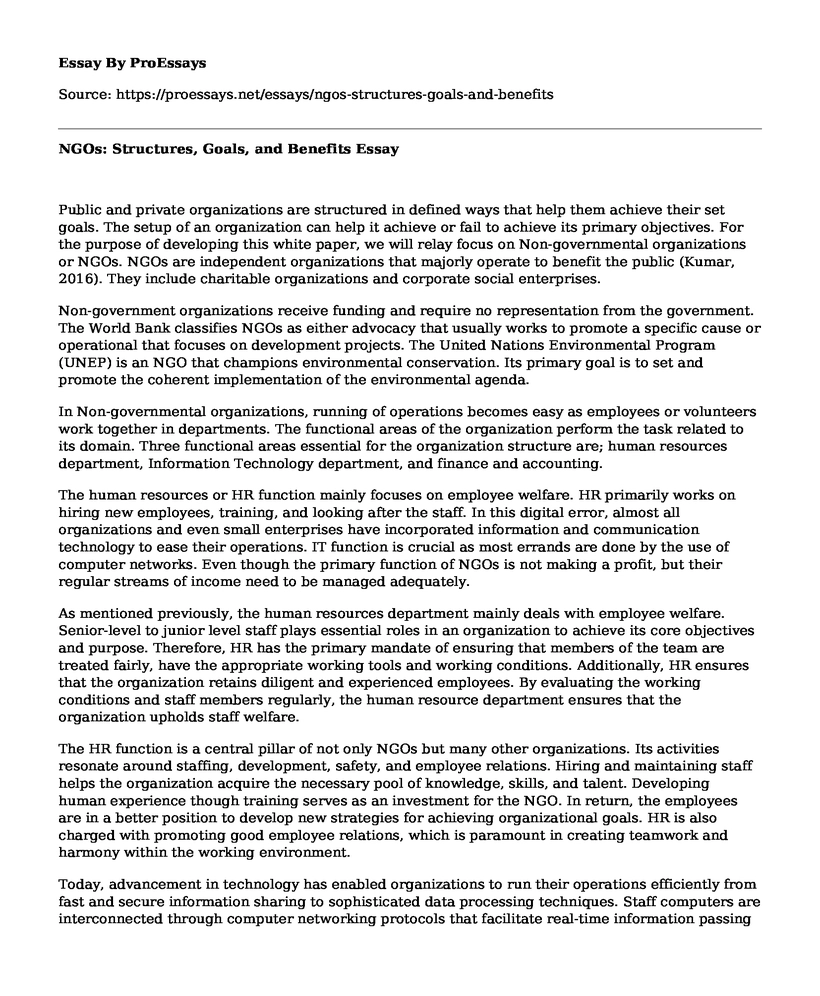Public and private organizations are structured in defined ways that help them achieve their set goals. The setup of an organization can help it achieve or fail to achieve its primary objectives. For the purpose of developing this white paper, we will relay focus on Non-governmental organizations or NGOs. NGOs are independent organizations that majorly operate to benefit the public (Kumar, 2016). They include charitable organizations and corporate social enterprises.
Non-government organizations receive funding and require no representation from the government. The World Bank classifies NGOs as either advocacy that usually works to promote a specific cause or operational that focuses on development projects. The United Nations Environmental Program (UNEP) is an NGO that champions environmental conservation. Its primary goal is to set and promote the coherent implementation of the environmental agenda.
In Non-governmental organizations, running of operations becomes easy as employees or volunteers work together in departments. The functional areas of the organization perform the task related to its domain. Three functional areas essential for the organization structure are; human resources department, Information Technology department, and finance and accounting.
The human resources or HR function mainly focuses on employee welfare. HR primarily works on hiring new employees, training, and looking after the staff. In this digital error, almost all organizations and even small enterprises have incorporated information and communication technology to ease their operations. IT function is crucial as most errands are done by the use of computer networks. Even though the primary function of NGOs is not making a profit, but their regular streams of income need to be managed adequately.
As mentioned previously, the human resources department mainly deals with employee welfare. Senior-level to junior level staff plays essential roles in an organization to achieve its core objectives and purpose. Therefore, HR has the primary mandate of ensuring that members of the team are treated fairly, have the appropriate working tools and working conditions. Additionally, HR ensures that the organization retains diligent and experienced employees. By evaluating the working conditions and staff members regularly, the human resource department ensures that the organization upholds staff welfare.
The HR function is a central pillar of not only NGOs but many other organizations. Its activities resonate around staffing, development, safety, and employee relations. Hiring and maintaining staff helps the organization acquire the necessary pool of knowledge, skills, and talent. Developing human experience though training serves as an investment for the NGO. In return, the employees are in a better position to develop new strategies for achieving organizational goals. HR is also charged with promoting good employee relations, which is paramount in creating teamwork and harmony within the working environment.
Today, advancement in technology has enabled organizations to run their operations efficiently from fast and secure information sharing to sophisticated data processing techniques. Staff computers are interconnected through computer networking protocols that facilitate real-time information passing (Terrill et al. 2018). The IT function work to maintain both software and hardware devices, maintaining servers, and securing the organization's information.
It is essential for organizations to have an IT department as reliable information helps align the organization's goals and the formulated strategies for achieving them. Communication is a fundamental concept in the running of any organization. The internet and technology have redefined communication, making it easier and faster. Through channels such as emails, video conferencing, and social media enables efficient communication. Proper communication functions facilitated by the IT team allow better communication hence achieving the organization's goals.
The finance and accounting function is another relevant functional are of an NGO. NGOs have a finance department that handles all money acquired and spent in their operations. The primary purpose of finance and accounting is to ensure transparency and accountability of organization resources. Also, executive managers are in a better position to make decisions based on accurate financial records. Continued organization success is achieved through proper channeling of funds to the right projects aimed at achieving growth and expansion. Finance and accounting managers support the goals of the organization by advising other managers about the organization's income and expenditure.
A good organization structure clearly defines specific roles and establishes a clear line of communication between the functional areas (Ahmady et al. 2016). I recommend a functional organization structure that comprises an overall CEO, directors for each functional area, and several managers under the directors. The directors have overall authority within the departments but are also allowed to share information to manages in the different functional areas. With this organizational structure, there is a direct communication line between departments; for instance, the HR director may want the financial manager to pay an authorized supplier of training equipment. This open communication makes operations much more accessible.
In conclusion, each functional area of an organization plays a vital role in the organizational structure. The link between the functional regions eases organization working and ultimately achieve the set goals. All other areas similarly require adequate dissemination of information and support from each other for the NGO to operate effectively.
References
Ahmady, G. A., Mehrpour, M., & Nikooravesh, A. (2016). Organizational structure. Procedia-Social and Behavioral Sciences, 230, 455-462.
Kumar, U. (2016). Nongovernmental Organizations (NGOs). The Encyclopedia of Postcolonial Studies, 1-7.
Terrill, J. O., Cross, T. J., Davis, S. M., & Zhang, Q. (2018). U.S. Patent No. 10,122,760. Washington, DC: U.S. Patent and Trademark Office.
Cite this page
NGOs: Structures, Goals, and Benefits. (2023, Sep 07). Retrieved from https://proessays.net/essays/ngos-structures-goals-and-benefits
If you are the original author of this essay and no longer wish to have it published on the ProEssays website, please click below to request its removal:
- George Washington History Has Impacted US the Most Essay
- Research Paper on Gender Inequality in America
- Heat Transfer From a Circular Cylinder Paper Example
- Essay Sample on Gas Lift
- Slavery in the South Essay Example
- The Role of the Superpowers in Conflicts in the Middle East - Essay Sample
- Sugar Shacks Essay Example







